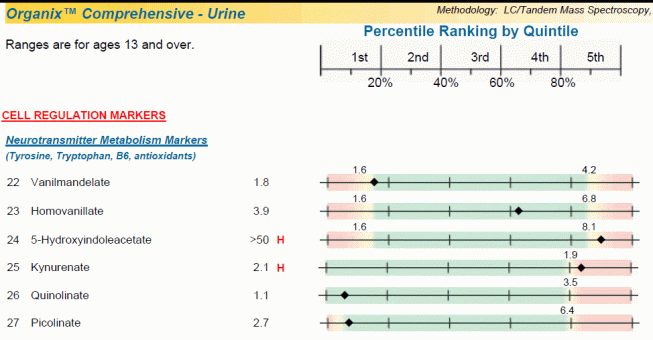Organic Acid Testing For Neurotransmitters
What are organic acids
Just like we need to eat and breathe, so do our cells. They take in nutrients and then excrete waste products. An organic acid tests measure some of these waste products. This can be used to uncover blocks in metabolism, some vitamin deficiencies, and some other thing such as neurotransmitter status.
Organic acids as functional markers of nutritional status
Sometimes the best way to test if have enough of a vitamin or nutrient is not in the blood. For example, on a blood tests some people may seem like that enough folate (folic acid). However, they feel better by taking a folate supplement.
Such a functional need may be seen on an organic acid test. One such organic acid is formiminoglutamate. Typically this is called to as FIGLU for short. FIGLU can be helpful to test because it is converted into glutamate by folate. Therefore if FIGLU is high on an organic acid tests, it shows a functional need for folate. [1]
Advantages to organic acid testing
- Organic acid tests shows if you have enough to meet your specific metabolic needs. Just counting up how much of any vitamin is in your blood may not do this.
- Not all vitamins are stored in the blood. For example vitamin B12 is stored in the liver. So how do we know that blood levels of B12 are the most accurate measurement?
- There are some metabolites for which there are no blood tests.
- Organic acid tests can reveal problems before they show up as deficiencies on other tests.
Organic acid markers for mental symptoms
B vitamin markers
Many B vitamins can be tested on an organic acid test. Two of the most important to consider with mental symptoms are vitamins B6 and B12.
B6 can be depleted by many medications (oral contraceptives, hypertension drugs) and exposure to common toxins such as pesticides. Symptoms of B6 deficiency include neurological problems such as poor balance, fatigue and mental/emotional instability. Vitamin B6 status can be tested with the organic acid xanthurenate. [2]
A vegetarian diet and poor digestive function are two of the most common causes of low B12 .B12 deficiency can present anemia, high homocysteine and neurological symptoms. Sometimes people are not anemic and have normal homocysteine, yet vitamin B12 deficiency is presenting only as neurological problems. Need for vitamin B12 need can be determined with methylmalonate.
Often people may have have a function need for vitamin B12, yes have normal blood serum levels. For this reason methylmalonate can be a more clinically relevant test.
Catacholamine testing
Homovanillate (HVA) and vanilmandelate (VMA), are by-products of dopamine, norepinephrine and epinephrine metabolism. These neurotransmitters are important for mental and neurological function.
- Low HVA indicates low levels of dopamine. This can indicate need for tyrosine and vitamins B6.
- Low VMA indicates decreased adrenaline and nor-adrenaline production. Tyrosine, B6, or copper, may be helpful. Low VMA may also indicate adrenal exhaustion.
Symptoms of low HVA and VMA include: depression, anxiety, sleep disturbances, inability to deal with stress and fatigue

In conventional medicine profound elevations of VMA is used to diagnose neuroblastic tumors. Functionally speaking, elevated VMA indicates stress. catecholamines. [3]

Serotonin
Metabolism of serotonin can be measured through the metabolite 5-hydroxyindoleacetate (5-HIAA). This represents total body metabolism of one serotonin pathway.
Low 5-HIAA indicates inadequate production of serotonin. Symptoms include: constipation, depression, fatigue, insomnia, attention deficit and behavioral disorders.
High 5-HIAA can be caused by SSRI medication, 5-HTP supplementation, increased release of serotonin from the central nervous system, digestive system or platelets. Very high 5-HIAA levels can ironically indicated a tryptophan deficiency, as this may cause an increased conversion of tryptophan to serotonin.
Elevated kyurenate and quinolinate indicate tryptophan is being used to produce inflammation instead of serotonin. High quinolinate levels in the brain can cause insomnia, irritability and nervousness. In this case the cause of inflammation needs to be treated. Simply giving the patient 5-htp and vitamins to make more serotonin is not going to work if those are just going to be converted into inflammatory cytokines. [4]

Other markers on organic acid tests
Organic acid tests can also be used to test detoxification pathways, metabolites of cellular energy function (to help determine need for supplements such as CoQ10) and there are even metabolites produces by bacteria in the G.I. system which can help show the cause of gastrointestinal symptoms.
Interpretation of organic acid results take some skill, so it’s best to have the guidance of someone familiar with the test. Interpretation should also take into account other factors which are not on the test, such as symptoms and medical history.
References
[1] Lord, Richard S., J. Alexander. Bralley, and J. Alexander. Bralley. Laboratory Evaluations for Integrative and Functional Medicine. Duluth, GA: Metametrix Institute, 2008. 348-350. Print.
[2] Lord, Richard S., J. Alexander. Bralley, and J. Alexander. Bralley. Laboratory Evaluations for Integrative and Functional Medicine. Duluth, GA: Metametrix Institute, 2008. 343-344. Print.
[3] Lord, Richard S., J. Alexander. Bralley, and J. Alexander. Bralley. Laboratory Evaluations for Integrative and Functional Medicine. Duluth, GA: Metametrix Institute, 2008. 351-352. Print.
[4] Lord, Richard S., J. Alexander. Bralley, and J. Alexander. Bralley. Laboratory Evaluations for Integrative and Functional Medicine. Duluth, GA: Metametrix Institute, 2008. 353-354. Print.